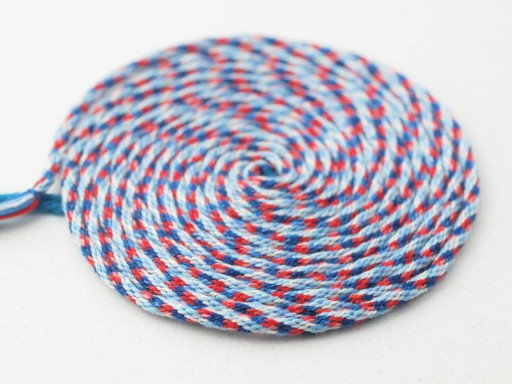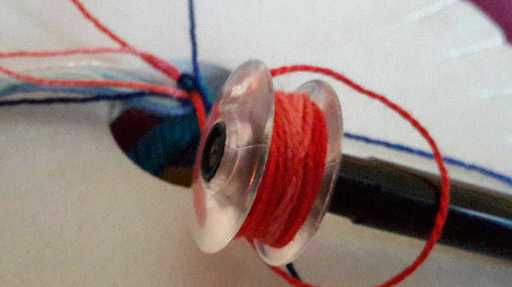This braid is quite similar in materials, design, and construction to the 12 strand kongo immediately preceding it; the biggest difference is that it's 16 strands, instead of 12. I wanted something with less white, so I added the pale blue. All three of the colored threads—the red, the dark blue and the pale blue—are variable. The red and blue are inexpensive colors that get shifted in intensity, rather than hue. The pale blue, however, goes from a turquoise through cobalt all the way to a lavender.

kongo braid, 84 inches long. 16 strands, on disk. Completed 24 Feb 2014.[1]
Once again, the plan is for this to be used as drawstrings in omiyage bags in red, white and blue patriotic fabric when we go to Japan.
If that crisscross pattern looks familiar, it should: it's standard for yarn balls, some spools of thread, etc. I have discovered it's an effective way to keep the thread from ‘hanging up’ or ‘catching’ (especially towards the ends of the spool) —basically what happens is that outer winds tighten up and ‘fall’ into lower layers, and then it's a royal pain to get it loose (in fact I have a modified paper clip with a hook on the end that I use in lieu of a crochet hook< [1]I know this because I happened to be visiting friends that day. I practiced my seza in a silent house while sunshine fell on me while I took this braid off the disk and warped the next one: the friends had an unbreakable appointment, and my traveling companion was napping. A lovely, low-key and peaceful time was had by all, for which kumi would be an excellent metaphor.
Unless otherwise noted, text, image and objects depicted therein copyright 1996--present sylvus tarn.
Sylvus Tarn
